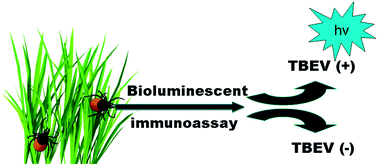Bioluminescent detection of tick-borne encephalitis virus in native ticks
Abstract
A one-step bioluminescent immunoassay for tick-borne encephalitis virus (TBEV) in natural ticks based on the hybrid protein 14D5a-Rm7 was developed. Recombinant Ca2+-dependent coelenterazine-binding protein was shown to be a more convenient substrate form for the Rm7 domain than coelenterazine. Over 600 samples of natural ticks were analyzed and shown to have essential differences in the discrimination factor D for TBEV-positive (2.77 ± 0.81) and TBEV-negative (1.15 ± 0.28) samples.



 Please wait while we load your content...
Please wait while we load your content...